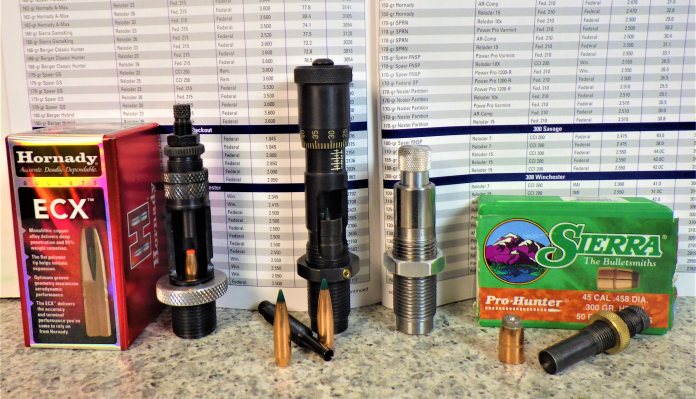Reloading Basics: Bullet seating
-
0
 Comments
Comments
- Last updated: 09/07/2023

Bullet seating may be the very last step in the reloading process, but it is also one of the most important. Getting it right is critical if you want to get your chosen projectile down the barrel consistently. The basic instructions that come with reloading dies can often be summarised as ‘sit the bullet in the case mouth and push it into place’, but there is a lot more to it than that.
Bullet seating is the ‘science’ of pressing the bullet into the case and setting it at the correct depth, straight and true, and undamaged. As you become more experienced, you will refine your own reloading process and get used to your own equipment, ensuring you make exactly what you want and make it as accurate as you can. As a part of this refinement, bullet seating is well worth concentrating on.
The depth at which you seat your bullets affects several variables, and they are all significant. Bullet jump, the distance that the bullet travels from the case mouth to the rifling in the barrel, has a direct impact on the stability your bullet achieves in flight, plus down-range accuracy. The seating depth also dictates how much free space there is left inside the case for the powder to burn, plus also influences the achieved chamber pressure.
By adjusting the depth, you will also alter the Cartridge Overall Length (COL) of your ammunition, affecting how it cycles from the magazine, and how it fits into the chamber. You should always use the COL stated in the reloading data you are using, and only deviate from it with care and due consideration of chamber pressure issues.
Although not actually a part of the bullet seating stage, correct case mouth preparation is critical to getting bullets seated correctly. Bullet tension is the grip that the case mouth has on the projectile, and this in turn has an effect on other factors like chamber pressure. When cases are resized, the mouths need to be sized so that the bullets can be seated straight, without being damaged, and there must be enough grip to hold the bullet so it cannot be rotated, pushed in, or pulled out. If the case’s mouth is too tight, and a lot of force is needed to seat the bullet, it is possible to damage the projectile at both ends. The case mouth can tear or gouge the back of the bullet, around the base, and the bullet seating stem can damage the area around the tip. Both types of damage will have a negative effect on the performance of your ammunition. If this type of damage occurs, you should seek a better match between neck size and bullet diameter.
There are various types of bullet seating dies available, and it is important to choose the right one. The seating dies included in die sets are perfectly good for producing good ammunition, but there are several more ‘specialised’ seating dies that can add to the quality of what you make. Bench-Rest, Competition, and even Cowboy dies, are all designed to provide ‘better’ and more effective bullet seating. These more ‘technical’ dies hold the bullet, the case, and the bullet seating stem in perfect alignment so that when the pressure is applied, they all come together as straight as possible. Dies with a micrometre allow you to fine-tune the COL far more precisely, and also record adjustments as you experiment with different lengths.
Bullet seating dies often perform two tasks at once, by seating the bullet and crimping the case mouth around it. It is very important to ensure that the die is adjusted correctly so that the timing of the two operations is spot on. If the main body of the die is set too low, crimping can be started too early, before the bullet has started to seat, and this can result in a collapsed case and a ruined bullet. The die must be adjusted so that the bullet is fully seated before the crimp is applied.
Seating the bullet involves pressing it downwards, into the case, while crimping the case mouth involves applying inward pressure from the sides. This means you have opposing forces acting on the cartridge that need to be timed absolutely perfectly to avoid problems. It is actually much better to separate the two processes, seating the bullet with one die, and then using a purpose-made die to apply the required crimp afterwards.
This small internal part of the bullet seating die is actually very important, and it plays a significant part in achieving good ammunition consistency. The profile of the inside of the stem tip must match (or be a reasonably close match) the profile of the nose of the bullet. The recess is usually shaped to suit the majority of bullet profiles for the given calibre, but some projectiles need special consideration. Plastic ballistic tips are easily damaged if the seating stem comes into contact with them, and the seating pressure must be applied to the ogive of the bullet, which is below the plastic tip. With a bit of very fine sandpaper and a bullet, you can actually re-profile the stem to give a perfect fit.
When you start seating a bullet, you should start with the seating stem set back slightly, so that you produce a cartridge which is slightly longer than the required length. You can then fine-tune the seating die to get to the correct COL. This method avoids seating a bullet too deep, and then having to pull it out and start again. If you are placing the bullets in the case mouths before you put them through the die, try to stand them as straight and true as possible. With seating dies that line the bullet and case mouth up for you, this is not necessary, because the die does it for you, and much more consistently.
